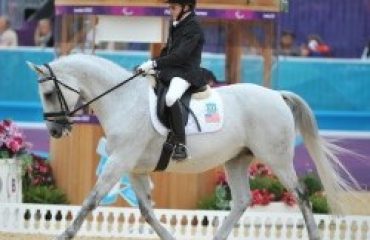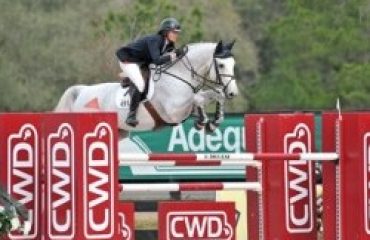
Boyd and Tsetserleg competing at the 2018 World Equestrian Games
Photo by Amber Heintzberger
Well known for both his fun-loving approach to life and his indefatigable work ethic, Boyd Martin has represented the U.S.A. in three-day eventing at two Olympic Games and two World Championships, and was on the gold-medal-winning Pan Am Games team in 2015. Boyd’s wife, Silva Martin, is a grand prix dressage rider and they have a son, Nox. Boyd and Silva train out of their own farm, Windurra USA in Cochranville, Pennsylvania, and spend winters at Stable View Farm in Aiken, South Carolina.
Can you break down your World Equestrian Games performance with Tsetserleg?
It’s always an honor and a privilege to represent the U.S.A. at a world championship, and I believe that our selectors chose a good team and we had excellent preparation, but things just didn’t work out on the weekend when it mattered.
My dressage test with Tsetserleg couldn’t have gone better; we’ve been working hard under the supervision of my wife Silva, dressage trainer Scott Hassler and U.S. Chef d’Equipe Erik Duvander, and it paid off with a beautiful test. He even got the flying changes right, which comes down to Silva’s hard work.
Obviously we had a disappointing performance on cross-country, where Tsetserleg ran out at one of the boats in the water complex, and again in show jumping where we had three rails down. I felt like I rode pretty well in the show jumping, but Tsetserleg felt a bit green and overwhelmed by the crowds and atmosphere.
I love Tsetserleg; he’s a tough, sound little horse and he still has a lot of room for improvement. With Shamwari taking an unexpected early retirement after Luhmuehlen this summer, Tsetserleg had to really step up to the plate with his selection to the WEG team. It was a lot to throw at him and he handled it well considering his inexperience; he’s still young and I think that in a couple of years, with more training and more experience, he’ll be hard to beat. I really feel that his best years are still ahead of him.
How do you cope with a disappointing result at a major championship like WEG?
While there are disappointing aspects of the WEG, I feel like it gives me the motivation to keep improving to be more competitive amongst the best riders in the world. I’m grateful to Tsetserleg’s owner, Christine Turner, and all of the sponsors, coaches, grooms and help back at the farm who contributed to making it possible for me to compete in Tryon. I also have to give a “shout out” to my wife, Silva, who left our newborn with the sitter to drive overnight with our 2-year-old son, Nox, to cheer me on Saturday, then drove straight home to feed the baby. Her support of my riding and love for our family means the world to me.
Eventers are a tough bunch and I was not the only member of the U.S. team who was right back at it the weekend after Tryon, competing multiple horses at the Plantation Field International. We’re all constantly striving to produce the next generation of horses and improve our own riding and performance. We might take a few hours or even a day to reflect on our performance, think about where things didn’t go well and how to do better next time, and then we’re back in the saddle and looking forward to the next opportunity or challenge.
How does a WEG compare to an Olympic Games?
As a professional event rider, every two years becomes a huge focus on either the World Equestrian Games or the Olympic Games; to people slightly outside the bubble of equestrian sports, this is sometimes the only time in which the result of a competition is very important. As riders, owners and supporters, it becomes an incredibly important contest, where you feel like everyone is watching you and any result will be regarded as standing of your nation on the international stage.
Selection for the Olympics and WEG are virtually the same: The horses and riders appear on the radar of the selectors about a year prior to the championship, there is usually a group of 15–20 horses and riders, and as the championship draws closer, that list gets thinned out. For eventing, it really comes down to your performance at the Kentucky or Badminton CCI4* and usually the best-performing, sound competitors make their way to the U.S. team.
Even though the competition is virtually the same — similar faces, team management, farriers and vets and so on — it does have a slightly different feel; at the Olympics there are athletes from more countries from a huge variety of sports and it feels like the whole world is watching. I suppose it carries a bit more prestige to be referred to as an “Olympian” – you’re not called a “Weggian” after you compete at a WEG!
That said, I do believe the winner of the WEG is the world’s best rider and horse in that moment in time. As a U.S. rider the WEGs I’ve experienced, at Lexington, Normandy and Tryon, the ultimate horse-and-rider combination did win the competition. I feel like the courses are sometimes more challenging at WEG and the field of horses and riders are more seasoned, generally speaking. Being at WEG is a little bit more relaxed; even though there’s security, you have a little more access to your owners and family members. There’s still a huge feeling that you’re competing at more than just a typical four-star.
The Olympics I’ve experienced, London and Rio, have more of a close-knit team feeling: You live in the athlete village, eat meals with your team, then take the bus to the venue — there are no sponsor signings, owner meetings or any of that; you’re locked in a bubble and focused on giving the best performance that you can.
Lastly, I’ll say the final result of a WEG or an Olympics is remembered for a lifetime. To me, winning an Olympic medal or World Equestrian Games medal is still above winning a regular four-star event, of which there are only five in the world.













